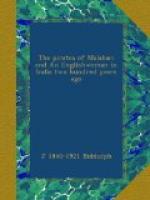[2] This was Oliver Levasseur, otherwise La Buze of
Calais, a noted French
pirate. By the English
he was called La Bouche, and, in one ship’s log,
Lepouse. On Woodes Rogers
assuming the governorship of the Bahamas, La
Bouche and England sailed
for Madagascar.
[3] Stevenson, in “Treasure Island,” evidently
took his idea of John
Silver, the one-legged pirate,
from this incident. “Now what a ship
was christened” (he
makes him say) “so let her stay, I says.
So it was
with the Cassandra
as brought us all home from Malabar, after
England took the Viceroy of
the Indies.... First with England, then
with Flint; that’s my
story.”
[4] Probably Stanton and Drage.
[5] In Lazenby’s narrative, England is mentioned
as Seegar, which was
probably his real name, England
being only an alias.
CHAPTER VIII
EXPEDITION AGAINST COLABA
Measures taken in England against pirates—Woodes Rogers at the Bahamas—Edward Teach—Challoner Ogle—Bartholomew Roberts killed—Matthews sent to the East Indies—Naval officers’ duels—Portuguese alliance—Expedition against Colaba—Assault—Defeat—A split in the alliance—Plot against Boone—His departure—Matthews’ schemes—His insulting behaviour—He quarrels with everybody—Goes to Madagascar—The King of Ranter Bay—Matthews goes to Bengal.
As long as their forces had been occupied with the French war and the Highland rising, the English ministry had been powerless to check the depredations of the pirates, which had become intolerable both in the East and West Indies. Now Europe was at peace, and measures could be concerted to put a stop to the evil. As usual, the Peace of Utrecht was followed by an increase of piracy, through the privateersmen being thrown out of employment.
On the 5th September, 1717, a royal proclamation was published, offering a free pardon, to all pirates on the American coast surrendering within one year, for all piracies committed before the 5th January. As rewards for the capture of pirate ships, to every captain L100, to other officers L40, to petty officers L30, and to ordinary seamen L20 were to be paid on conviction of the offenders. To pirates, a reward of L200 was offered for the surrender of a pirate captain or commander before the 6th September, 1718. The effect of the proclamation, in conjunction with the measures taken in the Bahamas, was very great. By the 1st July, 1719, to which date the time of grace was extended, all but three or four of the most desperate rovers had retired from business. But against the most audacious of them more vigorous measures were necessary.
It was of little use to hunt down pirates at sea, so long as their haunts in the Bahamas and Madagascar were allowed to flourish, and, as the West Indian rovers were the most mischievous to European trade, the Bahamas were first taken in hand.




